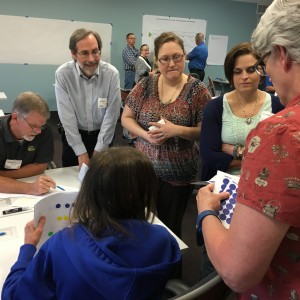Finding Solutions the Lean Way
By Travis Robinett
Having spent more than five months as a Pathways Intern at EPA Region 7, something I couldn’t help but hear about was EPA’s focus on Lean practices. In case you haven’t heard about Lean, it’s a method for process improvement. It’s about questioning the status quo of how you work, analyzing it, and making it better. And it’s becoming part of the work culture here in Region 7. We’ve already implemented more than 25 projects since 2013, and are currently working on several more.
It’s pleasant to see a federal agency take such a hard look at itself. It’s especially true here at EPA, because the more efficient and effective we become, the better we can fulfill our mission to protect human health and the environment.

EPA Region 7 staff work with state partners at the August 2016 event to improve the Clean Water Act Section 106 work plan negotiations process for Performance Partnership Grants. Region 7’s Process Excellence program is staffed with trained facilitators ready to tackle employee-recommended Lean projects.
I saw it for myself in August 2016, when Region 7’s Chris Taylor and Doug Jones co-facilitated a four-day event to improve the Clean Water Act (CWA) Section 106 work plan negotiations process for Performance Partnership Grants (PPGs).
I was in the room with 16 participants and two facilitators. The Region 7 states of Iowa, Kansas, Missouri, and Nebraska all sent leaders from their state water divisions, while Region 7 sent in managers and technical project officers from its Water and Wetlands programs, along with the staff who coordinate the process.
Going in, I wasn’t sure exactly what to expect. Trying to find solutions as a team sometimes works pretty well, but sometimes expectations aren’t met and people can leave in disagreement. With so many state agencies and EPA staff involved, all with their own unique needs, I was curious to see if everyone would be able to put their issues on the table, come up with solutions as a group, and move forward satisfied with those solutions?
Laying the Groundwork for Lean
To get the best results possible, these events are highly structured using Lean Six Sigma methodologies. Trained facilitators use certain tools in a certain order. They manage the team, keep everyone on task, and find a balance between the free expression of opinions, while still following the regimen. For example, if someone proposes a solution when the team is focusing on identifying the problem, the facilitator asks them to save the idea for later by putting it in the idea “parking lot.”
The facilitators do their best to make everyone productive and engaged. And to make that happen, they need everyone in the room to buy into Lean. So Taylor and Jones got to work.
After a basic orientation and laying the event’s ground rules, they demonstrated Lean’s effectiveness to the group by taking 30 minutes for the “Dot Activity.” Essentially it’s a game of production, where the group is assigned different roles, working together to make finished products (paper with colored dots placed in a certain order).
For the first round, the rules say to stick to the script, which is purposefully inefficient. After the 6-minute time limit, zero products were ready for the customer. Before the next two rounds, the group collaborated to change the process. By the third, they had made a natural assembly line and streamlined the process, and efficiency exploded. They made 28 products, and only took a minute to finish the first.
The Dot Activity highlighted some of the general ways a process can get bogged down, and how easy fixes can drastically increase efficiency. Just shifting around the work space saw dramatic results. It also got people into the mindset of process improvement and working as a team. Most importantly, it built comradery before really getting started, and got the team into good spirits.
The Process of Process Improvement
 One of the main tools used in Lean is the process map. The process is drawn out step-by-step to visualize it, analyze it, and then decide where to make it better. But before mapping, Taylor went around the room and asked everyone what they did and didn’t want out of the event, making sure everyone had their say.
One of the main tools used in Lean is the process map. The process is drawn out step-by-step to visualize it, analyze it, and then decide where to make it better. But before mapping, Taylor went around the room and asked everyone what they did and didn’t want out of the event, making sure everyone had their say.
The four states made it clear that nothing new should interfere with their internal work. EPA’s project officers wanted a better way to track grants through the process. EPA’s Water and Wetlands program staff wanted to make a consistent process that works with all four states. With this in mind, the mapping began. Four different maps were needed to account for the different processes with each of the states, along with a fifth map for the general timeline of the process.
Taylor drew out the maps by hand, step by step, with everyone’s input. Then he recreated them on his computer after the day was over, printing them for the next morning so everyone could double-check the results.
Once the maps were checked and edited, Taylor asked everyone for their “pain points” in the process, where they felt the process was breaking down, and for one thing they liked about the process and wanted to keep. From this, the group made three goals for the new process map: better collaboration from the start, better tracking methods, and better documentation in the process.
Next, the group split up to find potential solutions. They wrote them on sticky notes, reviewed them as a group, and placed them on a “Difficulty-Impact Matrix,” which compares impact to difficulty. The ideal solution is one that makes a big impact and is simple to implement.
In my opinion, the best idea was to have a series of “kickoff” meetings between EPA Region 7 and the states to establish clear work plan expectations from the start. This way, the states know more about any annual updates from EPA headquarters at the beginning of the process, and have a better idea of what to prioritize in their grants. Another solution was to use a shared, online tracking system so work plan progress can be checked instantly.
The next day, they drew a new process, one that would work for all four states, with their preferred solutions mixed in and every step accounted for. But even after the map was finished, the group wasn’t done yet. They made a rollout plan and assigned everyone tasks so the new process would be integrated smoothly.
The final step was the Report Out, where senior-level managers and other staff members came to see the event’s outcome presented, followed by a Q&A session. And when the states were asked whether they maintained their independence in the process, they all resoundingly said “yes.”
So in the end, the team came up with realistic and impactful solutions, along with a plan to implement them, and no one left in disagreement. And ultimately, it’s going to improve outcomes for cleaner water across the region.
This is what Lean and Process Excellence are all about. With these events happening more frequently and having more staff involved, the word keeps spreading. EPA Region 7 is all in on Lean, continuously striving to do better, and collaborating to get there.
Additional Information: Exploring the Clean Water Act and PPGs
What’s a Performance Partnership Grant (PPG)? It’s several grants in one, dealing with water, air, hazardous waste, and other state and EPA priority activities. In the case of this Process Excellence event, the grants are focused on the Clean Water Act (CWA) Section 106, which encompasses a variety of CWA activities.
The CWA  is complex. One of its main components provides for states to monitor their waters to see whether these water bodies are meeting different designated uses. For example, if a stream is not swimmable, or has poor habitat for wildlife, the states pinpoint the lacking water-quality metrics, then come up with a plan to fix the problem, known as Total Maximum Daily Loads (TMDLs). And that’s just one of many tasks involved in the CWA.
is complex. One of its main components provides for states to monitor their waters to see whether these water bodies are meeting different designated uses. For example, if a stream is not swimmable, or has poor habitat for wildlife, the states pinpoint the lacking water-quality metrics, then come up with a plan to fix the problem, known as Total Maximum Daily Loads (TMDLs). And that’s just one of many tasks involved in the CWA.
Just in Section 106, funding is provided for:
- Monitoring and assessing water quality
- Developing water quality standards
- Identifying impaired waters and TMDLs
- Managing National Pollutant Discharge Elimination System (NPDES) permits
- Ensuring compliance
- Implementing enforcement actions
- Protecting source water
- Managing outreach and education programs
It’s not cheap to carry out these activities. So the federal government provides grant money to states with delegated programs. The states write the PPG work plans, which plan and budget for their fiscal year CWA 106 activities. These plans are then negotiated and ultimately approved by EPA.
About the Author: Travis Robinett has been a Student Intern at EPA Region 7 since June 2016. He is a second-year graduate student at the University of Kansas (KU), working toward a master’s degree in environmental assessment, and holds two bachelor’s degrees in journalism and English from KU. Travis has a passion for sustainability, public service, teaching, volunteering, and the great outdoors.

